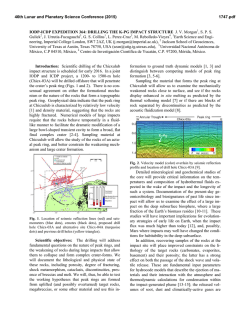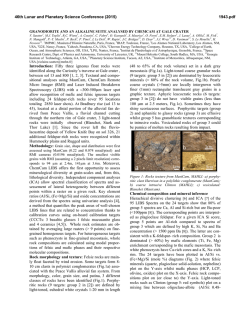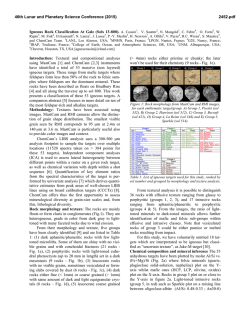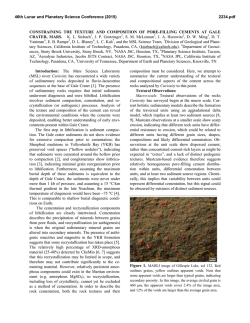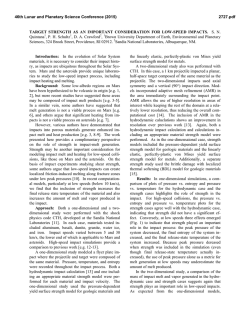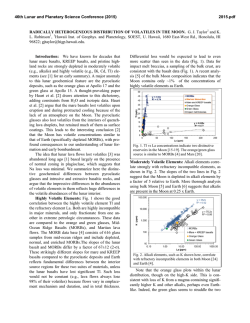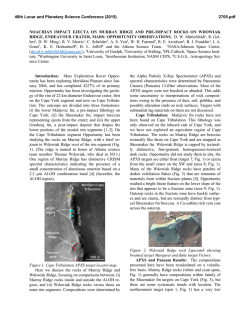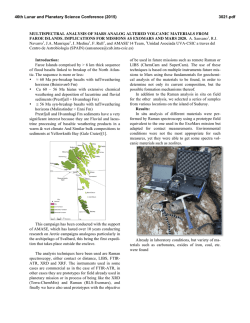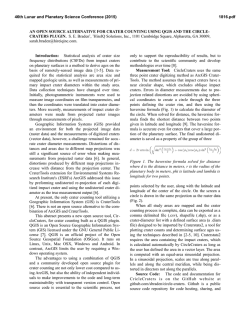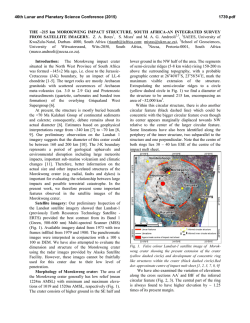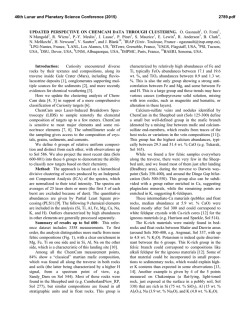
Identifying Extraterrestrial Signatures in Mafic Impactites
46th Lunar and Planetary Science Conference (2015) 1520.pdf IDENTIFYING EXTRATERRESTRIAL SIGNATURES IN MAFIC IMPACTITES: AN ASSESSMENT BASED ON THE LONAR CRATER, INDIA Christian Koeberl 1,2 and Toni Schulz 2, 1 Natural History Museum, 1010 Vienna, Austria ([email protected]), 2 Department of Lithospheric Research, University of Vienna, 1090 Vienna, Austria ([email protected]). Introduction: During crater formation a small amount of projectile material, generally less than 1 wt%, can be incorporated into impactites (impact melt rocks, suevites, impact glasses, and ejecta), resulting in a measurable geochemical signal. Such extraterrestrial (ET) components have, so far, been identified for just over ~40 out of the ~185 currently known terrestrial impact structures [1]. The vast majority of these structures are excavated in felsic targets (i.e., continental crust), making attempts for the geochemical identification of ET signatures rather straightforward. It remains, however, difficult to detect ET signals for the rare examples of impact craters formed in mafic lithologies. Tools for the identification of ET signatures generally take advantage of compositional differences between the impactor and the terrestrial target. For the most commonly applied tools, highly siderophile element abundances (e.g., platinum group elements [PGEs]), as well as 187Os/188Os compositions, the differences between meteorites (i.e., chondrites and iron meteorites) and the terrestrial target diminish the more mafic the latter is, making it more difficult to distinguish between the indigeneous and the meteoritic component. Fig. 1: Lonar impact crater, India (ASTER image). The Lonar crater, India (Fig. 1), is one of the rare terrestrial examples of an impact crater excavated in a mafic target, namely the continental flood basalts of the ~65 Myr old Deccan traps. The crater has a diameter of 1830 m and its floor is occupied by a shallow saline lake. The formation age of Lonar crater was determined at ~0.57 Myr [2]. In the absence of actual meteorite fragments, the impact origin was mainly support- ed via the presence of shocked plagioclase (e.g., [3]), as well as meteoritic components of up to 17% postulated based on Cr, Co, and Ni abundances within aerodynamically shaped impact spherules found in the Lonar area [4]. In an attempt to search for a meteoritic signature within the impact melt and breccia rocks, we here present an assessment of the first PGE and Os isotope data for impact melts, breccias and target rocks from the Lonar crater, India. Methods: The samples analyzed for this study were described by [5] and [6]. Target rocks lack any obvious evidence of impact-generated shock features and were collected from basalt flows exposed in the upper 50 m of the crater wall. In contrast, impact melt rocks and breccia samples were either collected outside the crater rim within the ejecta blanket or inside the crater rim and around the Lonar Lake. About 1 to 3 g of powdered sample material was spiked with a mixed tracer composed of 99Ru, 105Pd, 185Re, 190Os, 191Ir, and 194 Pt isotopes and digested in a HNO3/HCl (5+2) acid mixture at 250°C and 125 bar pressure in an AntonPaar high pressure asher for 12 hours. Osmium was purified using carbon tetrachloride (CCl4) based solvent extraction techniques as described in [7], followed by microdistillation purification [8]. The Os total processing blank was 0.5 ± 2 pg (n = 5). Rhenium, Ir, Ru, Pt, and Pd were separated and purified from the residual acid by conventional anion exchange techniques using AG1x8 resin. Total blanks (n = 5) averaged at 515 pg for Re, 1-3 pg for Ir, 20-70 pg for Ru, 10-30 pg for Pt, and 20-50 for Pd. All Os isotope analyses were performed using a Thermo Triton Thermal Ionization Mass Spectrometer, equipped with an SEM detector, used in negative mode at University of Vienna, Austria, whereas the contents of rhenium and the PGEs were measured using a Thermo Element ICP-MS in single collector mode at University Bonn, Germany. Results: Platinum-group element abundances and chondrite-normalized PGE patterns for all samples are broadly similar to that of the average upper continental crust. However, several impact melt rocks exhibit a factor of 2 to 20 higher Ir, Os, and Ru concentrations (up to ~113, ~202 ppt and ~806 ppt, respectively). The elevated PGE contents in several impact breccia rocks are also significantly higher compared to basalts from other areas within the Deccan traps, averaging at 25.1 ± 7.2 ppt for Ir [9] and 6.5 ± 2.8 ppt for Os [10] and ~200 ppt for Ru [11]. Rhenium concentrations are sig- 46th Lunar and Planetary Science Conference (2015) 10 Target basalts Impact breccia rocks Mixing curves UCC Upper Continental Crust 187Os/188Os nificantly lower in impact melt rocks and breccias (mostly <200 ppt) compared to target basalts (mostly >200 ppt). Notably, both lithologies exhibit an apparent dichotomy in Re/Os ratios, which are significantly lower in impact melt rocks and breccias (0.7 to 10.9) compared to the target basalts (4.9 to 53.7). The impactites with the highest Ir, Os, and Ru concentrations and the lowest Re/Os ratios consistently show PG interelement ratios that are up to an order of magnitude closer to the chondritic value compared to all other analyzed rocks. Measured 187Os/188Os isotope ratios of rocks from the Lonar area range from slightly superchondritic to highly radiogenic (0.1652 to 2.283), with impact melt rocks and breccias exhibiting on average lower ratios (ranging from 0.1652 to 0.6000). Discussion: Lonar rocks analyzed in this study do not define an isochronous relationship and exhibit considerable scatter on a Re-Os isochron plot with all samples plotting above a 65 Myr reference isochron [10], possibly arguing for post-crystallization disturbance. However, consistently lower Re/Os and near chondritic 187Os/188Os ratios within most impact melt rocks and breccias compared to the target basalts point toward the presence of an extraterrestrial admixture in the impactites. Modelling the relation between 187 Os/188Os ratios and Os concentrations in impact melt rocks and breccias in comparison to the target rocks has proven to be a robust means of quantifying small meteoritic components and constraining the mass input from impactors in impact rocks (e.g., [12]). As demonstrated in Fig. 2, our data for impact melt rocks and breccias show a good fit to a calculated mixing curve between a chondritic and basaltic end-member (see Figure caption for details). If interpreted in terms of a meteoritic component, some of the analyzed impact melt rocks and breccias have the highest amount of projectile contamination. Although mafic targets generally complicate a PGE and Re-Os isotope based search for an extraterrestrial contamination in impactites (especially in the Lonar area, where intense weathering and assimilation of Archean basement might contribute to element mobility as well; [13]), we conclude that the our observations can be best explained by the addition of up to ~0.02 % of a chondritic component to some of the Lonar impact melt rocks and breccias. These results are comparable to magnitudes of meteoritic admixtures of impact melt rocks and breccias from similar sized craters (e.g. [14]), but in contrast to the enormously high meteoritic components of up to 17 wt.% postulated for (suspected) impact spherules from the Lonar area [4]. A more detailed discussion based on additional data is in progress. 1520.pdf UCC 1 0.1 0 50 100 150 200 250 Os [ppt] Fig. 2: Plot of 187Os/188Os ratios vs. Os concentrations for target basalts and impact melt and breccias rocks. The curves show mixing between two target basalts and a hypothesized impactor material of carbonaceous chondrite composition [15]. For comparison, the upper continental crust is also shown (star; data from [16]). Acknowledgements: We than Ambre Luguet, David van Acken and Wencke Wegner for their contributions to the data acquisition and interpretation. References: [1] Koeberl (2014) Treatise on Geochemistry; [2] Jourdan et al. (2011) Geology 39, 671674; [3] Fredriksson et al. (1973) Science 180, 862864; [4] Misra et al. (2009) Meteoritics and Planetary Science 44, 1001-1018; [5] Ghosh and Bhaduri (2003) Indian Minerals 57, 1-26; [6] Osae et al. (2005) Meteoritics and Planetary Science 40, 1473-1492; [7] Cohen and Waters (1996) Analytica Chimica Acta 332, 269-275; [8] Birck et al. (1997) Geostandards Newsletter 20, 19-27; [9] Crocket and Paul (2004) Chemical Geology 208, 273-291; [10] Allègre et al. (1999) Earth and Planetary Science Letters 170, 197-204; [11] Crocket et al. (2013) Journal Earth System Science 122, 1035-1044; [12] Lee et al. (2006) Meteoritics and Planetary Science 41, 819-833; [13] Chakrabarti and Basu (2006) Earth and Planetary Science Letters 247, 197-211; [14] Koeberl et al. (2014) Geochimica et Cosmochimica Acta 58, 1229-1234; [15] Shirey and Walker (1998) Annual Reviews Earth and Planetary Science 26, 423-500; [16] Peucker-Ehrenbrinck and Jahn (2001) Geochemistry, Geophysics, Geosystems 2, 1061, doi:10.1029/2001GC000172.
© Copyright 2026
